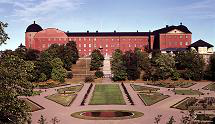Speaker
Dr
Alicia Sanchez Lorente
(Helmholtz Institut Mainz)
Description
Hypernuclear research will be one of the main topics addressed by the PANDA experiment at the planned Facility for Antiproton and Ion Research FAIR at Darmstadt (Germany). Thanks to the use of stored antiprotons beams, copious production of double lambda-hypernuclei is expected at the PANDA experiment, which will enable high precision gamma spectroscopy of such nuclei for the first time, and consequently a unique chance to explore the hyperon-hyperon interaction.
In comparison to previous experiments, PANDA will benefit from a novel technique to assign the various observable gamma-transitions in a unique way to specific double hypernuclei by exploring various light targets. Nevertheless, the ability to carry out unique assigments requires a devoted hypernuclear
detector setup. This consists of a primary nuclear target for the production of Xi + Xibar pairs, a secondary active target for the hypernuclei formation and the identification of associated decay products and a germanium array detector to perform gamma spectroscopy.
Moreover, one of the most challenging issues of this project is the fact that all detector systems need to operate in the presence of a high magnetic field and a large hadronic background. Accordingly, the need of an innovative detector concept will require dramatic improvements to fullfil these conditions and that will likely lead to a new generation of detectors. In the present talk details concerning the current status of the activities related to the detector developments for this challenging programme will be given.
Among these improvements is the new concept for a cooling system for the germanium detector based on a electro-mechanical device. Additionally, it will be shown how the use of techniques based on pulse digital shape analysis can be applied to restore the energy resolution and line shape of radiation damaged germanium crystals. Furthermore, since the momentum resolution of low momentum particles is crucial for the unique identification of hypernuclei, an analysis procedure for improving the momentum resolution in few layer silicon based trackers is presented.
Primary author
Dr
Alicia Sanchez Lorente
(Helmholtz Institut Mainz)

